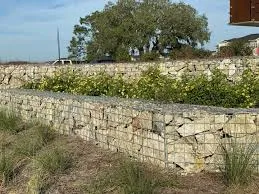-
 Phone:
Phone: -
 Email:
Email:

mesh rock retaining wall
The Benefits and Applications of Mesh Rock Retaining Walls
Retaining walls are essential structures designed to hold back soil and prevent erosion, particularly in areas with sloped terrain. Among the various types of retaining walls, mesh rock retaining walls have gained prominence due to their unique benefits and versatile applications. This article will delve into the features, advantages, construction methods, and applications of mesh rock retaining walls.
What is a Mesh Rock Retaining Wall?
A mesh rock retaining wall consists of a robust framework of metal or plastic mesh filled with rocks, gravel, or other materials. This innovative design leverages the weight of the rock and the structural integrity of the mesh to retain soil effectively. The open structure of the mesh allows for drainage, which is crucial in preventing hydrostatic pressure build-up behind the wall.
Advantages of Mesh Rock Retaining Walls
1. Erosion Control One of the primary functions of a retaining wall is to prevent soil erosion. Mesh rock retaining walls are particularly effective in sloped areas, where water runoff can wash away soil. The rock fill within the mesh acts as a barrier, stabilizing the soil behind it and reducing erosion.
2. Natural Aesthetics Unlike traditional concrete or masonry walls, mesh rock retaining walls can be designed to blend seamlessly with the natural landscape. The use of natural stones allows for greater aesthetic appeal, making them suitable for residential areas, parks, and other public spaces.
3. Flexibility and Adaptability Mesh rock walls can be constructed in various shapes and sizes, making them adaptable to different site conditions. They can be designed to handle varying soil types and can be adjusted to meet specific engineering requirements. This flexibility makes them suitable for a wide range of applications, from small residential projects to large-scale commercial developments.
4. Cost-Effectiveness Compared to traditional retaining wall systems, mesh rock walls are often more cost-effective. The materials used are generally more affordable, and the construction process can be faster and less labor-intensive. This cost efficiency makes them an attractive option for many developers and contractors.
5. Improved Drainage The mesh construction allows for excellent drainage, which is crucial in preventing water accumulation behind the wall. This feature minimizes the risk of wall failure due to hydrostatic pressure, ensuring long-term stability.
Construction Methods
Building a mesh rock retaining wall typically involves several key steps
mesh rock retaining wall

- Site Preparation The area where the wall will be constructed must be cleared and leveled. Proper drainage considerations should also be made during this phase.
- Foundation Setup A solid foundation is crucial for stability
. A trench may be dug to provide a level base for the wall.- Mesh Installation The mesh is erected in the desired configuration, ensuring it is anchored securely to withstand the lateral pressures from the soil.
- Rock Filling Once the mesh is in place, it is filled with rocks or gravel. This filling process is critical, as the weight of the material directly influences the wall's ability to retain soil.
- Finishing Touches After filling, the area around the wall can be landscaped as needed, and additional drainage systems may be installed to enhance water management.
Applications
Mesh rock retaining walls are commonly used in various applications, including
- Residential Properties Homeowners use them to stabilize sloped yards, create terracing, and enhance landscape aesthetics.
- Infrastructure Projects In civil engineering, these walls are employed to support roadways, railways, and bridges, particularly in hilly or mountainous regions.
- Commercial Developments Businesses leverage mesh rock walls to manage site grading and improve the visual appeal of their properties.
In conclusion, mesh rock retaining walls offer a practical and visually appealing solution for soil retention and erosion control. Their flexibility, cost-effectiveness, and natural aesthetics make them a popular choice for various applications, ensuring they will remain a relevant option in construction and landscaping for years to come.
-
Wire Mesh for Every Need: A Practical SolutionNewsJul.25,2025
-
Steel Fences: Durable, Secure, and Stylish OptionsNewsJul.25,2025
-
Roll Top Fencing: A Smart Solution for Safety and SecurityNewsJul.25,2025
-
Cattle Farm Fencing Solutions for Maximum SecurityNewsJul.25,2025
-
Affordable Iron Binding Wire SolutionsNewsJul.25,2025
-
Affordable Galvanized Wire SolutionsNewsJul.25,2025
-
Wire Hanger Recycling IdeasNewsJul.25,2025








